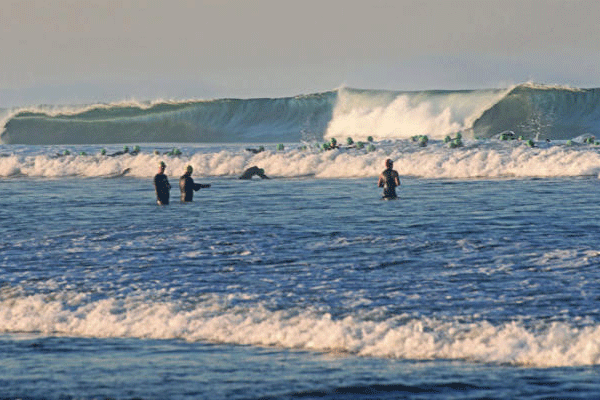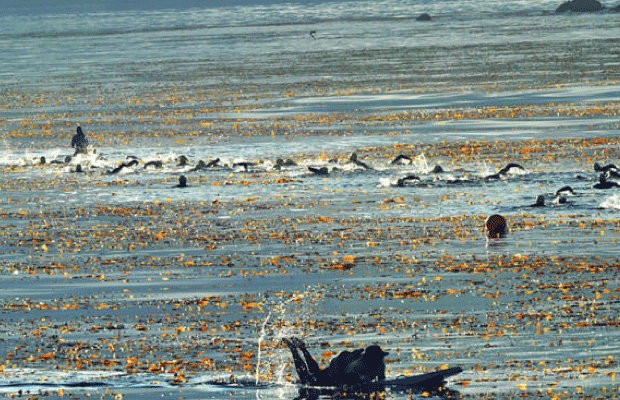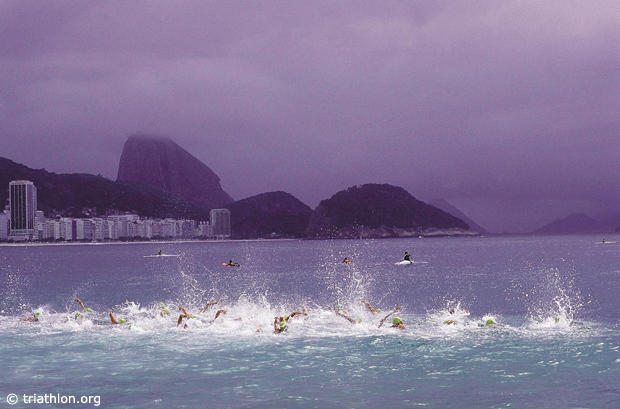Rio Swim: On, Off, Back On
Yesterday the AP reported on crisis levels of viral contamination in the water venues at Rio de Janeiro, site of the 2016 Olympic Games, and more imminently the site of this upcoming Sunday's Rio Test Event where many of the World's top Olympic hopeful triathletes will jump into the soup… the cauldron… the Petri dish… the water.
In fact, the beach where the triathlon swim occurs, Copacabana, is among the cleanest in Rio. It is tested regularly, the tests sent directly to the ITU. Further, the ITU – which is almost alone worldwide among race organizations and governing bodies – has established strict water safety standards for its swim venues, which include testing for two classes of bacteria taken at various points of the swim venue over various times during the year. This is written into the ITU's guidelines.
Slowtwitch obtained a test of the waterborne bacteria at Copacabana Beach from the 24th of July showing that the bacterial levels were under the ITU's threshold, such threshold marginally tighter than the State of California mandates for its beaches.

But the AP reported today, in a follow-up to its article of the day before, that in a test taken on the 27th of July bacterial levels at Copacabana were above the threshold levels. Per the ITU's own rules, the swim would not be conducted in this case.
Slowtwitch traded a number of emails with Ms. Greene yesterday as a result of yesterday's AP article. Ms. Greene is in Rio for the Test Event. During this email exchange the copy of the water report from the 24th was sent to us. Yesterday was the 30th of July, so why was the report from the 27th of July not referenced by Ms. Greene?
"The test on the 27th didn't come to us," said Ms. Greene, "as it wasn't one of our required tests but rather a standard test the city carries out every two to three days and makes public on their website. We learned about it this morning. The City does tests every two to three days, so the test was done on the 27th but published today or maybe yesterday as there is a 72-hour turn around."
"But the good news," continued Ms. Greene, "the City was due for another test and had it done yesterday and we requested that it be expedited. It was and the results are again within acceptable levels. High bacterial levels can occur when there is heavy rain, which there was over the weekend when the test was done on Monday. We haven't had any rain in five days now and don't expect any over the weekends, so the levels should all remain clear for the weekend. Additionally , the point at which the test was high is outside of our venue. While it's in the Copacabana, the specific testing point is outside of the course."
Accordingly, one story line we're following is whether there will be a swim leg or not during the Rio Test Event this upcoming Sunday, August 2nd. While this is a day-to-day saga, smart money seems to be game-on for a 3-leg race.
A second line of interest is in whether bacterial testing alone is sufficient to determine the safety of a body of water. The AP's story from yesterday casts doubt on that thesis, important because water quality for swimming is determined through using only bacterial levels as indicators of nastier germs. This is universal: every water agency, everywhere. Virtually no public health department tests for viruses as part of its water safety protocol.
Slowtwitch contacted Dr. Kristina Mena, quoted yesterday by the AP as an expert. She is associate professor at the University of Texas Health Science Center at Houston, and its Program Head of Environmental and Occupational Health Sciences. She affirms the tenor of yesterday's AP article, that while bacterial counts have formed the basis for water quality programs, current thinking is that these are reliable indicators for some classes of viruses but not for others.

California does not close its beaches when the bacterial count exceeds its thresholds. Rather it places warning signs on its beaches. It only closes its beaches during a sewage spill, and this is thought by some to be evidence that California parses between a moderate versus severe threat of viral contamination, the sewage spill representing the latter.
However the City of Malibu, just West of Los Angeles and home to movie stars and moguls, is a historic anomaly. It incorporated partially or primarily as a tactic to maintain its system of individual septic tanks rather than be forced to adopt a central sewage system. These septic systems range right up to the beach, where swimmers and surfers cavort and where, by the way, a 3000-plus-person triathlon occurs every year.
There will be a change in years to come in Malibu, and a sewage system will replace the septic tanks that leak into the Pacific Ocean, but that's not now in place.
The outstanding question is one of context. What is the viral load where epidemiologists and environmental health scientists start hyperventilating? Is it 200, or 1000, units per 100ml? Which virus? Adenovirus? A different virus? And what is Copacabana's viral report card? What is the viral load at that beach, regardless of what the bacterial testing says? How does it compare to Malibu? To Santa Monica, and to Miami?
These are the questions we're asking, and when we know we'll report them in these pages.


